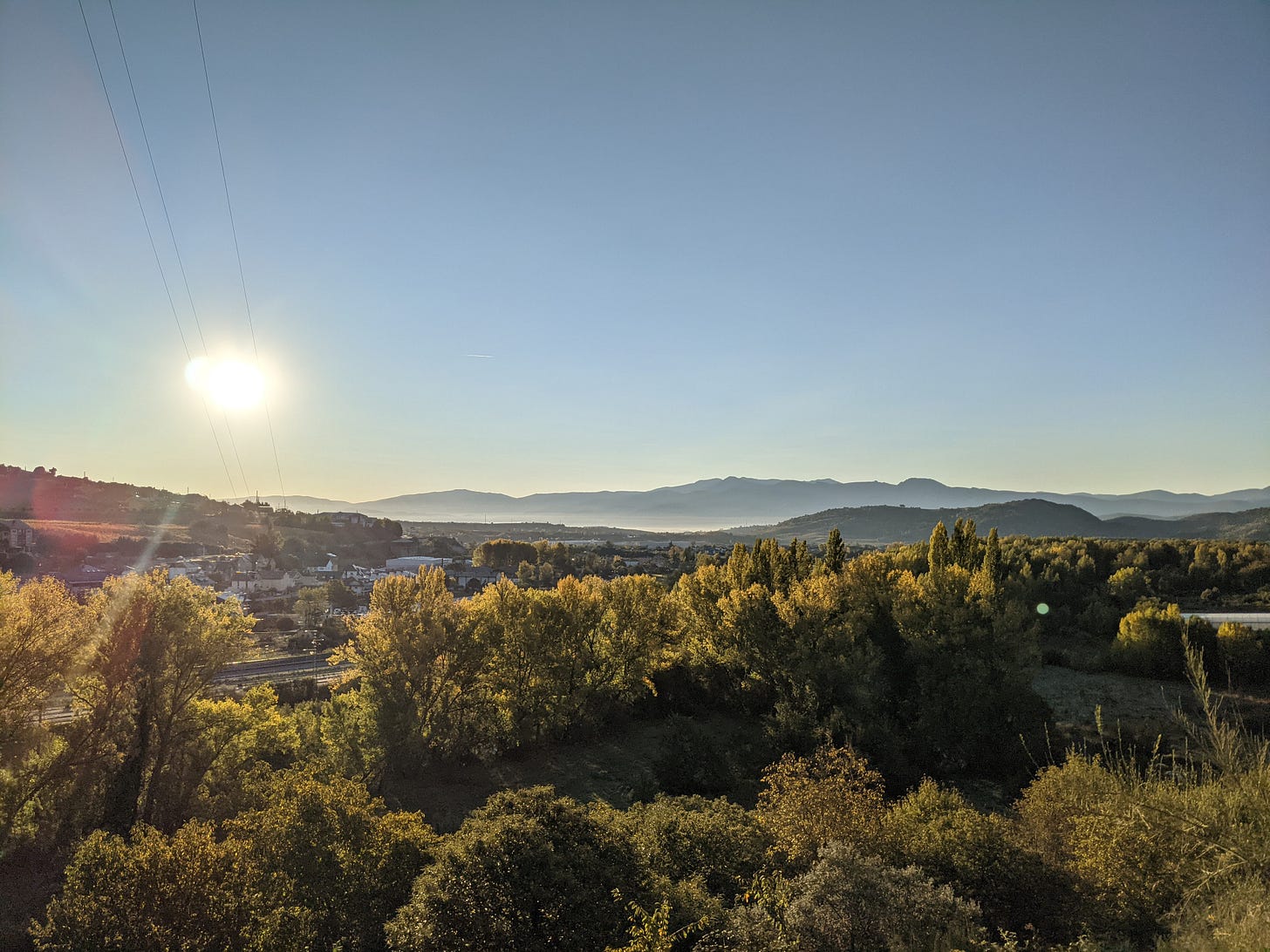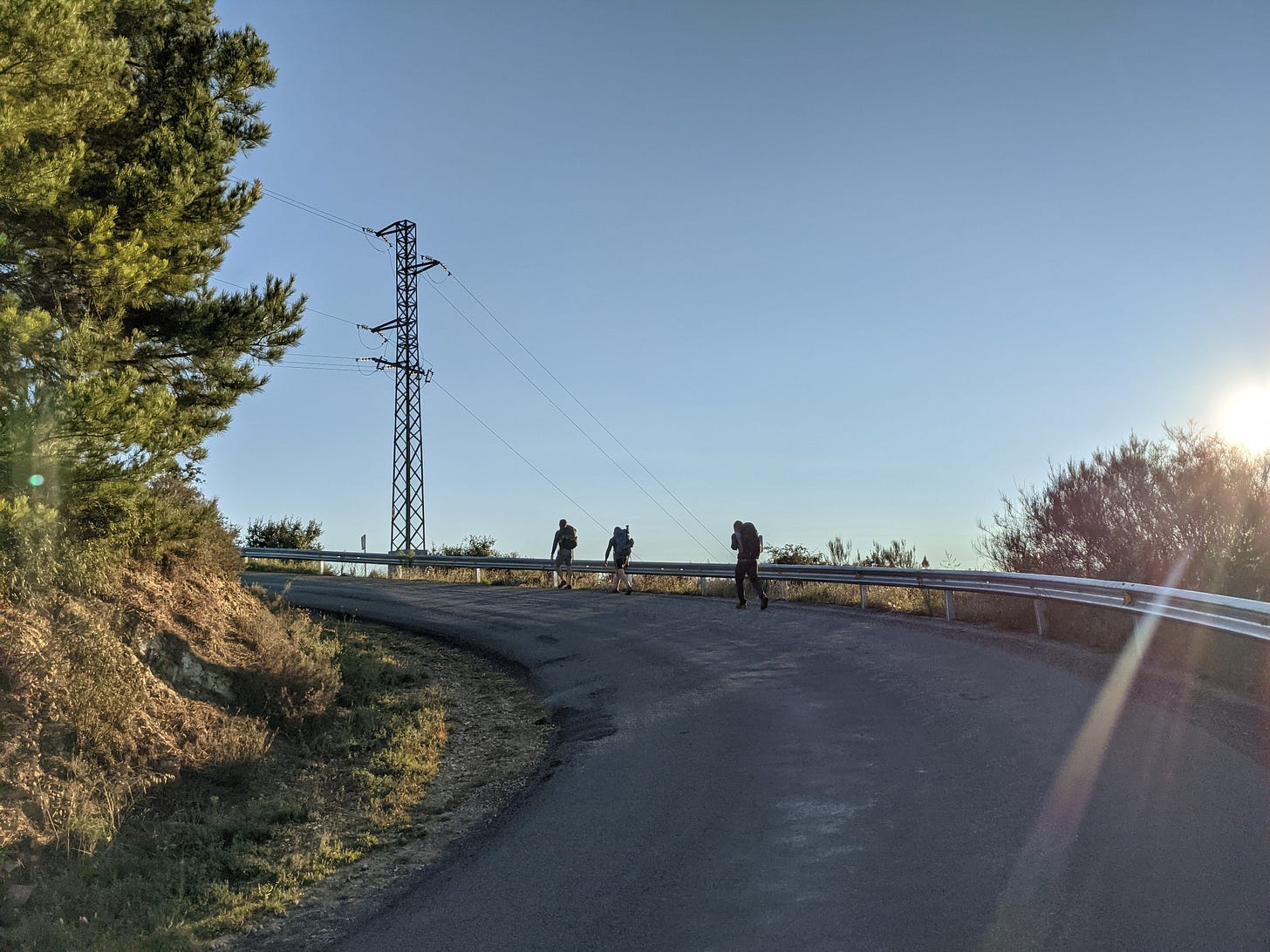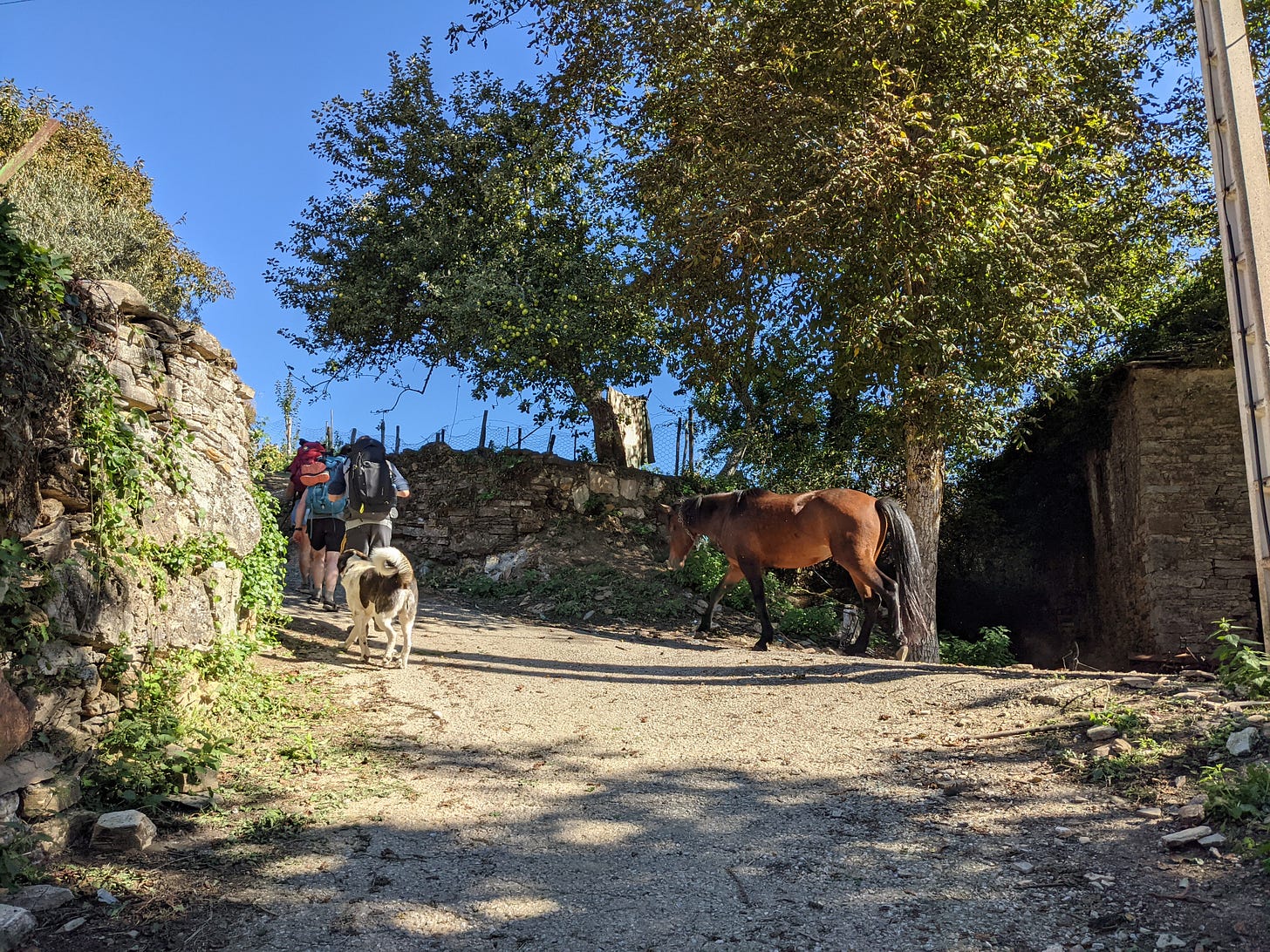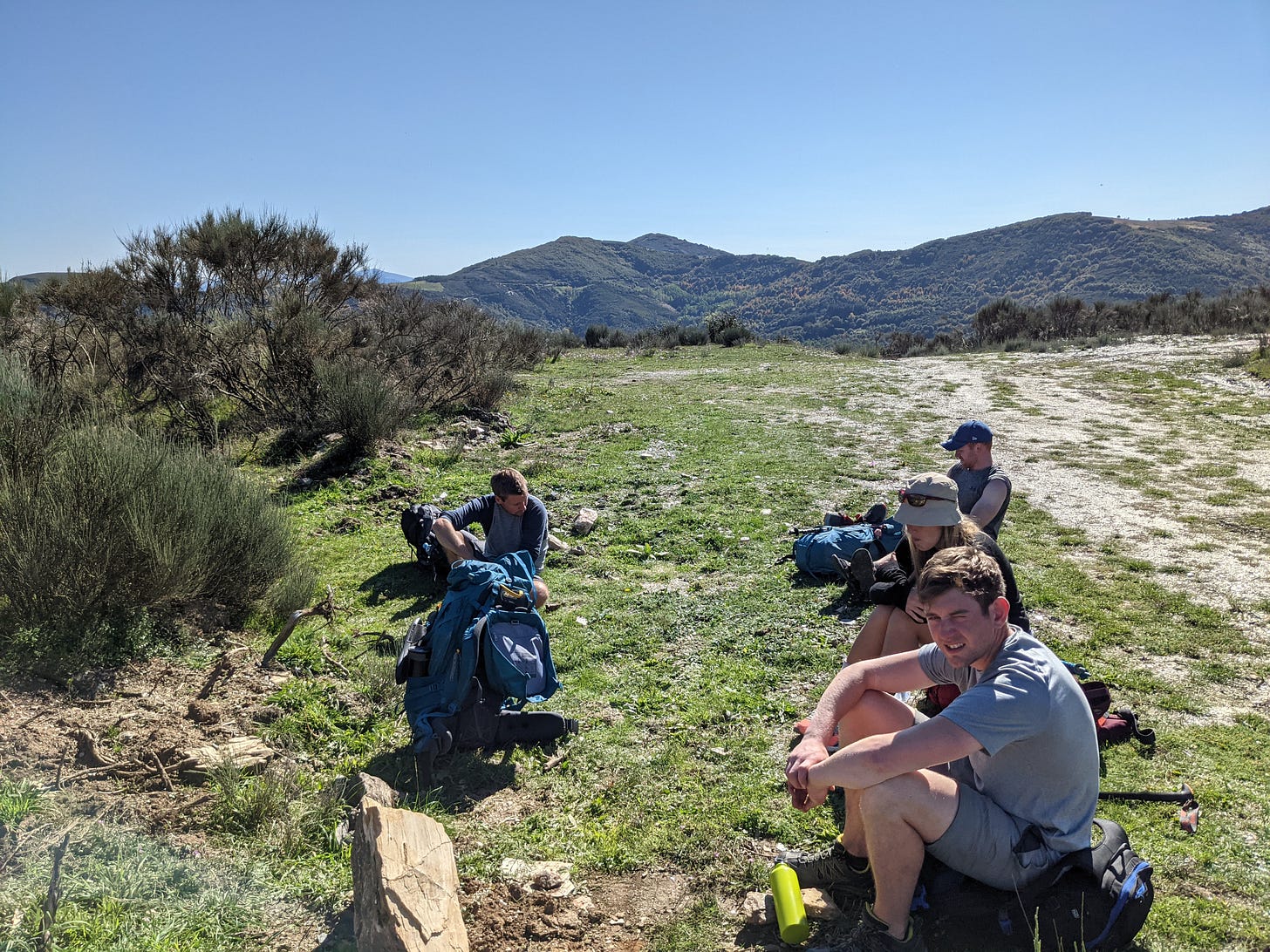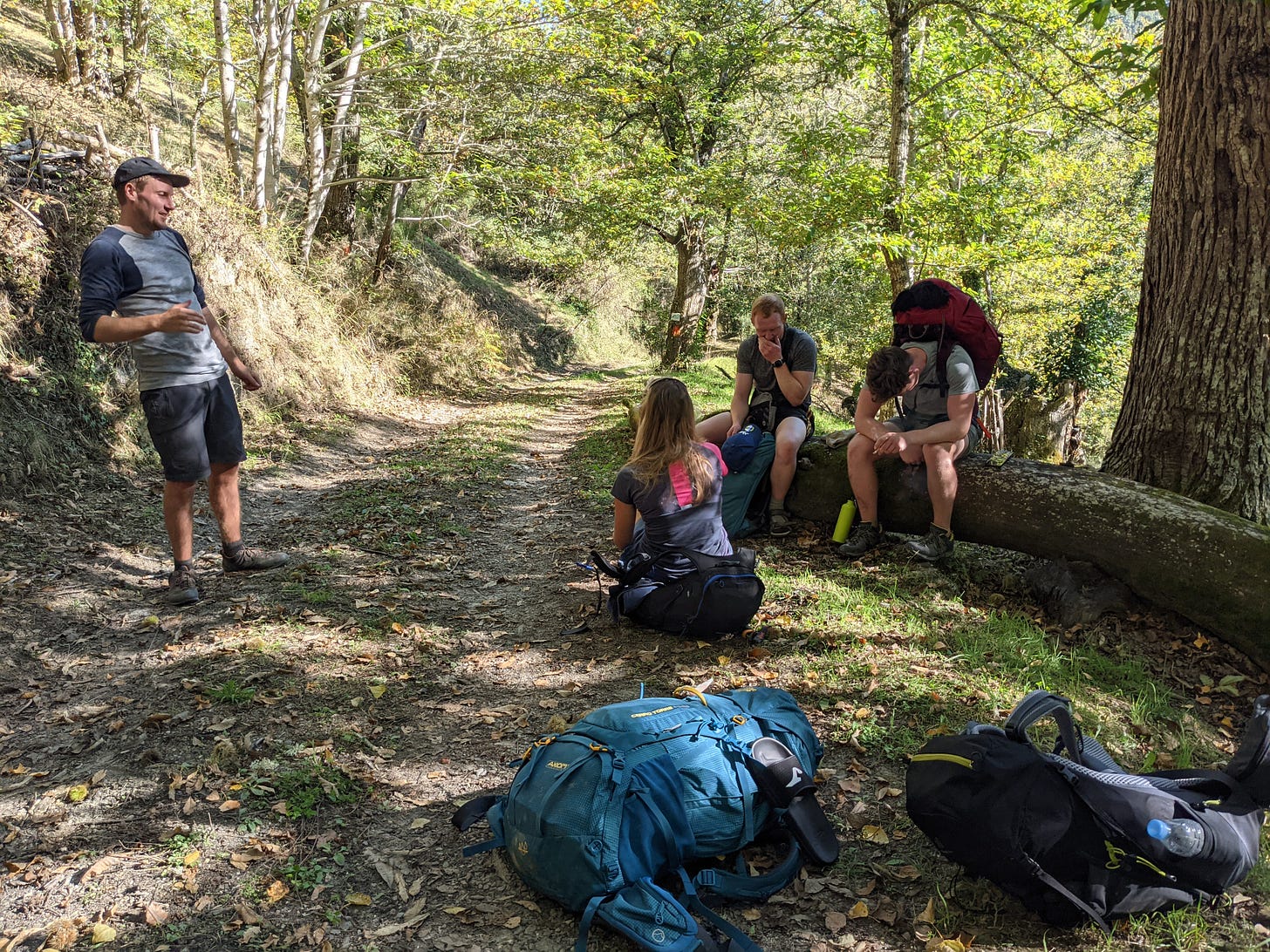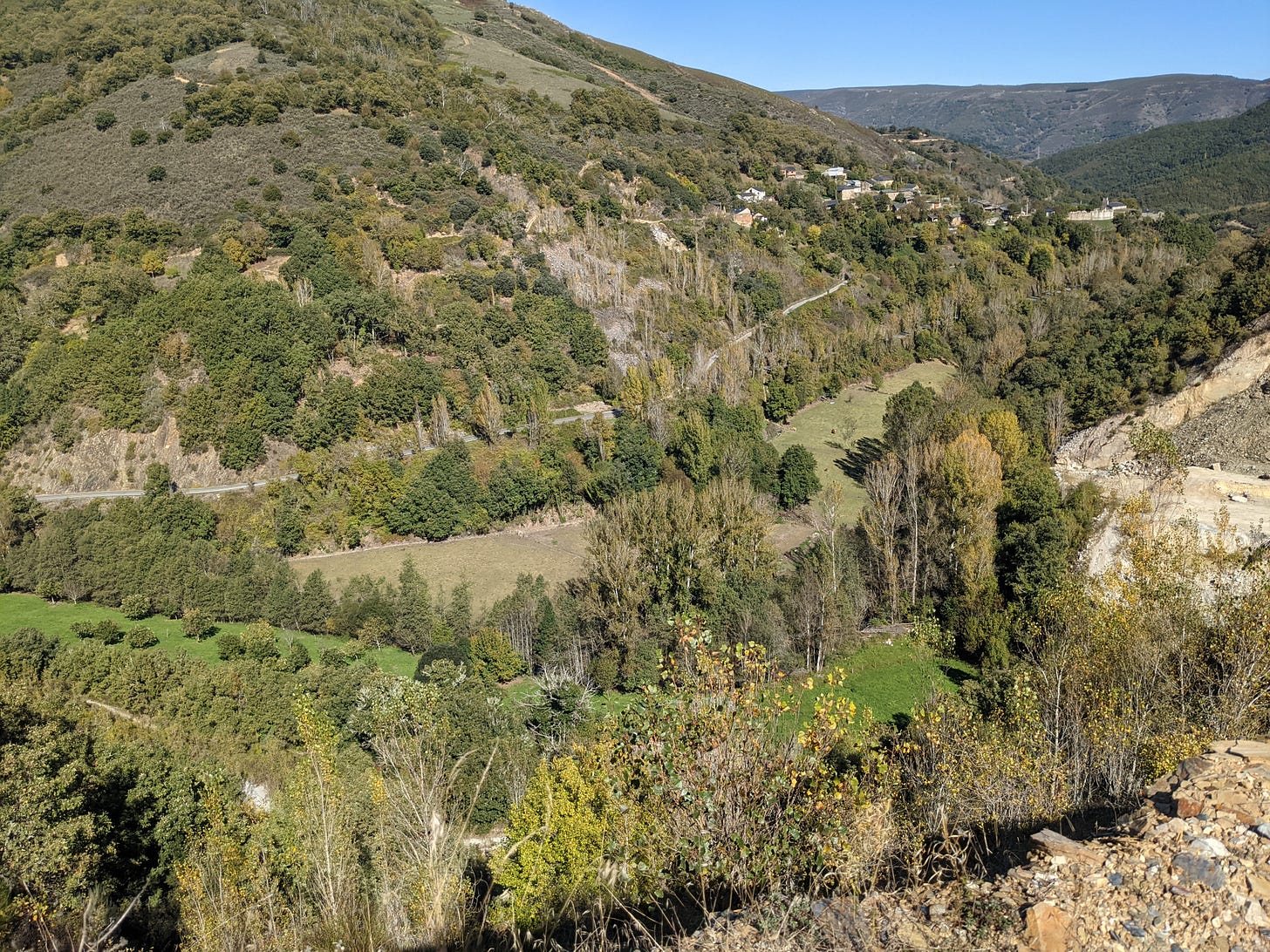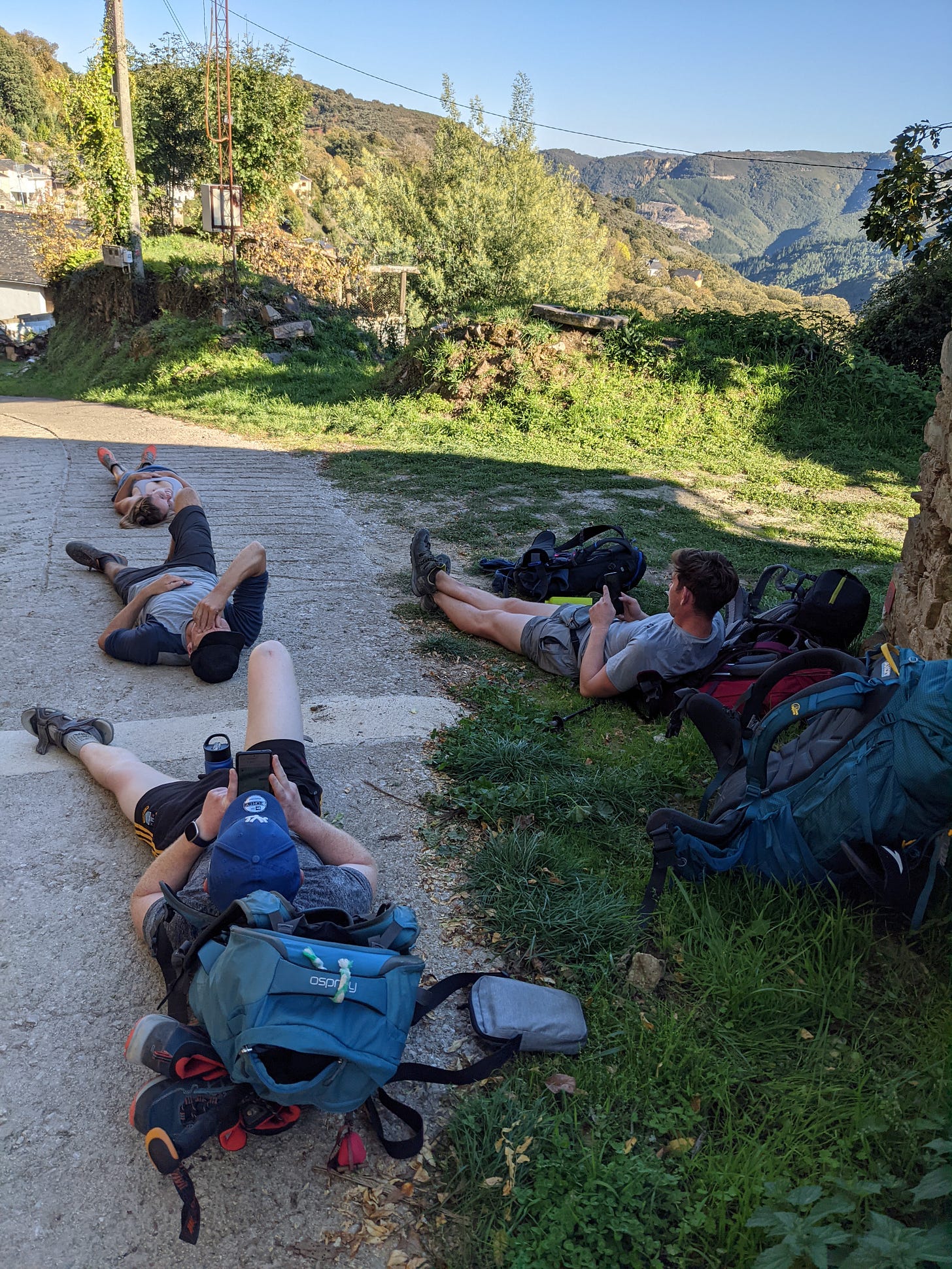Camino de Santiago Day 27: Villafranca del Bierzo to A Laguna
This is a big one: I finally learn what it takes to go Beyond
I’m currently publishing a day-by-day account of my adventure on the Camino de Santiago. If you’d like to keep up with it, or if you’re interested in more stories and essays about travel, the outdoors, physical movement and the journeys they take us on, then Subscribe Now.
‘Los Cincos’ (‘The Five’)
We already have a nickname when we arrive in A Laguna. It’s about 10 past 9 at night. It’s been dark since before 8. Everyone in the village knows us as ‘Los Cincos’ as well. You might even call us the Famous Cincos.
The Camino Dragonte
We left about 9. Villafranca still waiting for the sun to reach in through the mountains.
There are 2 alternative routes today: I’d been told about them by Karen from Rhode Island, who I met in Poblacion 2 weeks ago. There’s the Scenic Route – over a mountain, and the Dragonte Route – which goes up through the village of Dragonte and crosses 3 mountains. The primary route follows the highway
I always choose nature and the higher ground. Dragonte it is. It’s got 3 mountains with a total of 1,500m elevation gain, but sure it’ll be fine if I’ve the whole day for it. It sounds like others are interested, though most decide to err on the side of caution and take the more straightforward route, or the normal scenic route.
A few friends are on for it: Conor and Gary, from Birr; Nathalie from Switzerland and Henrik from Denmark.
It’s tricky enough to find the way as there’s no signs, but we find the nice tarmac road which takes us uphill for 5 or 6km, up up and into the mountains. The views are stunning, the sunrise slow and powerful.
Going off-piste
We take our first break in Dragonte. It’s grand so far – if it’s like this the whole way, sure won’t we be fine? Condors circle ahead as we go off-piste across a field. Our first downhill and into the next village. Not so bad: we’ve already cleared one of the three hills – each of them a 500m climb – up and then down again. Making decent time.
The village is marked Moral de Valcarce on Google Maps and in the guidebook, though it’s a very down-to-earth mountain village; collection of a couple of houses and farms, with barely a road running through it. The tarmac has given way to a dirt track strewn in leaves. The only inhabitant is a farmer pulling a trailer of pumpkins. He doesn’t seem to care much for our presence and just keeps shouting at his friendly-looking dogs, though as he draws level he makes a motion like he’s flapping the mouth of a sock puppet: these dogs bite.
I don’t know how long it would take you to reach this place from the road, or from another village, even by car. We’ve already descended into a remoteness where it’s clear that there are different rules and norms out here.
The road disappears down and into a forest. We have no idea where we’re going as it splits in two. We all start getting our Bear Grylls hats on and figure out we need to keep descending before we can climb the next hill, and follow the sound of a distant stream to get to the lowest point. The guidebook offers scant details that serve more as clues than directions, one of which is that we must wade through a shallow stream for 50 metres or so before we can ascend on the far side.
We’re in a thick forest of chestnut trees, a kind with a green spiny shell. The weather has been the hottest it’s been on the whole trip this week, even though we’re in mid-October. Cold, even frosty mornings, hot evenings, the change in the seasons signified mostly by regular flurries of falling leaves, their large dry forms often giving a bit of weight to their impact, accompanied by a similar falling of chestnuts, which I’ve come to realise do have quite the potential to cause you an inconvenience if they time their landing right.
This has turned already into more of what you would call a ‘hike’ than anything we’ve done on the Camino, and it does make you kind of long for more of that on the road, rather than the mix of road and pathway that usually makes up the route, or the stark sense of duty that seems to accompany any section that’s more technical. It is quiet, blissful, though as more conkers fall with a regularity that’s more like precipitation than the random if seasonal death of a species of plant, I lean over my phone as I take notes; if one were to fall and land on the screen of my phone (and they carried a weight that would endanger my head, never mind the screen of my flimsy device, then all the nature in the world wouldn’t be able to console me.
Despite the exertion we’re putting in it feels already like we’re on a holiday away from the Camino – a unique environment, no peregrinos and typical conversations, not even a shop, nor even a waymarker to tell us we’re on the Camino. It’s a mental holiday as much as anything.
Another steep climb – both climb and descent have been tough so far, though the fact we’re coming close to the top of the second hill means we’ve a sense of confidence building. It’s bang on 1pm when Gary rings the bell of the small church – or chapel, really – that marks the way into Vilar de Corrales, another dirt road out of the forest into another mountain village.
The Horse
The village dogs have been set off by the bell (though at least it was rung on the hour) and act tough standing on the road, though they’re more bite than bark. With them though is a horse, whom we presume is attached to the tree she’s standing beside by the large chain that’s draped around her neck. It’s just jewellery though – as we walk by them the dog does nothing and the horse joins us at our walking pace, which looks lazy for him, befitting the lean barrel of her body and the heat of the day. The only man in this village – presumably the horse’s owner, stands watching us from a wooden balcony. He smiles and waves hello, but otherwise doesn’t move.
The horse follows us up the village, which is more the lengthy yard of a farm, and stops for water when we do at the village fuente. We haven’t had a chance to fill our bottles since Dragonte. The day continues to heat up as we climb out of the village, the track steep as before.
The horse keeps following us. She stops every so often to pick at some grass but other than that seems content to follow our pace. She looks hungry, tired, thirsty, maybe just bored. In need of a haircut. At one point we make ground on her as she picks at roadside grass, but the distance she falls behind only spurs her to break into a gallop to catch up to me, one that I’m not sure til quite late she’s going to arrest before she reaches me.
We reach the top of the second peak, another 500m gained over the course of a few kilometres. The horse is still with us – it’s about 2km from the village. No sign of the farmer. We’ve no idea what to do as it’s apparent now that she’s going to follow us all the way to Santiago if we let her. We joke that maybe we could ride he; she speaks neither Spanish nor English and doesn’t consider going home. It’s obvious she needs to follow someone and Conor volunteers to lead her back down the hill and into a field, before turning and doing a runner before she has a chance to turn and spot him. We’re not entirely sure he’ll come back as we sit for a lunch break.
The Last of the Food?
We’re a bit under-prepared, as a group. The only lunch we have is the end of the baguette, packet of cheese and meat, along with some chocolate that I’d bought – and eaten most of – in Molinaseca a couple of days ago. I’d half-heartedly emphasised that there’d be nowhere to stop today, though it’s hard to fully get behind things you’ve only read in a guidebook and don’t actually know. We’ve passed three of the six villages on the route and there’s definitely been no shops nor restaurants.
Another sharp descent past an enormous quarry, before we get into the third village: San Fiz do Seo. It’s 3pm and as with the past week, the day’s only getting hotter. We find nowhere to eat though we manage to fill our bottles with water at the church fountain. We still have 16km left to go for the day, though we feel a bit better when we hear from our friends that they’re still very much walking and have 8 still to do themselves.
The environment though is incredible, and more than ever the forests we pass through seem to form a scaffold of light around us, the shadows and the light combining to shape a world around us. A lady sweeps her porch, in keeping with the others, she’s the only soul we see in this town.
We’re getting hungry now. It’s been about 3 or 4 kilometres between villages, though all they’ve provided us with water – at least there’s that. I tell the rest that the book says there’s a kind of restaurant in the next one, another 4km ahead, though it sounds more like a lady who’ll cook food for pilgrims who find her – we’re very much in the land of the traditional ways now.
It’s starting to become a slog. Flies are amassing around us, attracted to the sweat we’re working up or maybe just the stench of hardened hikers. We’re on the last of the three hills, and although less steep it is never-ending. We take a wrong turn, then come to a fork, both of which end up in dead ends. We have to think long and hard as a group which way we’re going to bet on will take us to the next village. Some of our phones aren’t working, batteries are draining, we’re out of water, and these flies are really, really starting to aggravate us.
We trace our steps back and find the right way, the hill just gets steeper now. It’s a beautiful path. We break on a felled tree stump and nearly all sit in a lump of dog shit. People start panning out on the floor. Just another few hundred metres. We make it.
The Last of the Water?
There’s no-one in this village either. There’s no shop. No café. No lady who’ll cook us food. An elderly woman in a red cardigan is sitting in the shade of her porch on the edge of town. I ask if there’s water around and she runs me, her voice croaking, she points furtively and tells me I’ve to go to Las Herreiras, the next place over. Another 4km. We’re all out of water.
Nathalie speaks Spanish. She asks politely if there’s any around.
“No.”
“Do you have water?”
“No!”
“We’ll pay you for water?!”
“Vamos!”
She’s eighty-something and having none of it. We go up the road and collapse to the ground. It’s starting to look grim. Another 4km, we’re all out of water, no food in sight. It’s the hottest it’s been on the whole trip. Flies are amassing on us. My shorts have gotten noticeably looser than they were this morning.
The Last Hill?
One last push. We’ve no other choice. More hills. The whole bloody thing is up a hill. It’s tough. Very much a case of mind over matter now. Just keep walking. You’re going to be tired either way. Might as well just keep pushing. I have to stop at some point as my legs are starting to get weak. I’m getting an adrenaline sweat. My heart is pounding and I’ve to sit down. Conor and Nathalie catch up and they’re the same, a redness in their faces that’s looking like heat stroke. We’re nearly there.
Are we nearly there? We go on. Near the top of the final hill. It’s hotter than ever, though at least now there’s more shade. It’s hours, an almost 8km since we last got water. No food bar the sandwich I shared three villages back. Fairly extreme heat for us northern Europeans. And those flies.
Finally – I see civilisation: an enormous suspension bridge in the distance with a busy highway. It’s not where we’re going but it can’t be far. The last of my phone battery tells me it’s 2km – yet another steep downhill. The mindset has shifted entirely, a second or third or tenth wind. With the end in sight I’m able to run down the hill at times, following another dirt track down and into Las Herreiras.
We’ve made it. Over 30km and 1,500m over three peaks, mostly off-road. With no food and no little water. We get sandwiches and short-lasting cold beers in a restaurant.
Karen from Rhode Island
I recognise a lady having dinner with her husband: it’s Karen from Rhode Island. She’d told me about the Dragonte route two weeks ago when I was making small-talk with her in a small family-run hotel. It’s a pretty remarkable synchronicity that she’s right here just as we finish – I hadn’t really seen her since the few days after I first met her. She’s delighted we did it and wants to take our photos.
It’s almost dark. There’s a twist though: we’re not done. We’ve a reservation with our friends in A Laguna, which is just below the peak of the next mountain, which marks the famous border-crossing to Galicia at O Cebreiro.
We’re getting messages. The guy is closing the kitchen soon. He offers to send a taxi for us.
We say “no”. We’re going to finish this out no matter what.
It’s getting dark. There’s about 15 minutes of light left as we leave. It’s another 500 metre ascent over 6 or 7 km. And we’ve to do it in the dark. We march on.
Ultreia
At this stage it’s every man and woman for themselves. It’s just how it has to be. No-one is going to get us up the hill only ourselves. Darkness falls and my headlamp does little to light the path as we move off the alpine road and into a wooded trail. I am exhausted: legs, lungs and my little brain. It’s just one foot in front of the other. There are rocks underfoot, and earlier in the day or week they’d have caused grief for my still inflamed shin though now I stomp them underfoot like I want to smash each one to pieces.
The path is dark and jagged though it doesn’t matter, every step I take with head down is firm. Having gone from one layer of clothing to 4 as the night quicky cooled leaving Las Herreiras, I strip back down to a t-shirt, the sweat pouring out of me again.
Onwards, upwards and beyond.
Whereas the final hill of the Dragonte route took what I would describe as ‘mental strength’: tricks and discipline of focusing the mind so it doesn’t get distracted by worries or emotions or negative thoughts, this final ascent and assault on the earth is an altogether different thing. It requires not physical nor mental toughness but a complete detachment from who I think I am. It is one foot in front of the other and nothing more. Like the climb to Foncebadon before it, which took a small fraction of the effort required today, I strengthen as I walk despite being truly and utterly exhausted by all standards and sense. This is the point where you are reduced to the very fibre of your being, where all your attachments are stripped away until you become nothing, and no-one, and yet you move stronger than ever. All those days I’d strived and promised myself that I’d go “beyond” the ordinary, the mundane, and the normal limits of my abilities – I never did. It was always too easy to stop, to check into an albergue, to meet a friend for a drink, and ultimately to make excuses. There was nowhere to run – or to stop – today. Throwing ourselves out into the elements with little preparation, and by the end of it, we wouldn’t have it any other way. There is no physical challenge nor mental challenge anymore. We just go for it. I realise it’s the most present I’ve been on the entire trip. Sometimes the only way to achieve it is to entirely exhaust yourself, and not just that, your assumptions of what you even think is possible. Navigating the steep ascents and descents, we all fell silent. There was no room at those moments to consider contrived notions of “Why?” or “How?” you’re doing the Camino – all you could do, was do it.
Getting close to the top, over an hour of this furious assault on the mountain, as if I am punishing it and want to destroy it beneath my feet, which could only be done if I were bigger than it – right now, I am. The moon and the stars are out, the hillside is almost bright in the light. We’ve done almost 40 kilometres, and 2,000 metres of climb over 4 mountains, with little water and no food. I have well and truly gone Beyond what I thought was possible. The beautiful irony is that I couldn’t and wouldn’t have done it without a group of friends in tow.
Los Cincos (part 2)
“Ah!” says the moustachioed hospitalero behind the bar. He ushers us to the dining room to a set table. He knows we’re coming:
“Los Cincos!”
If you’ve done the Camino, are thinking of doing it, or are just interested in discussing the Camino or travel in general - then please leave a comment. I’d love to hear from you.




